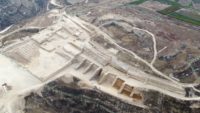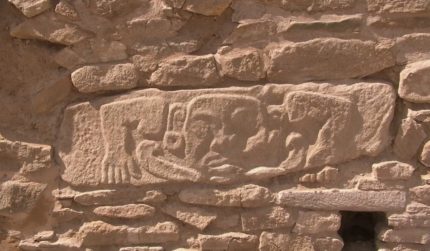 Reliefs carved on stone walls at the Neolithic site of Shimao in Shaanxi, northern China, are strikingly similar to the characteristic motifs found on bronzeware made hundreds, even thousands of years later during the Chinese Bronze Age.
Reliefs carved on stone walls at the Neolithic site of Shimao in Shaanxi, northern China, are strikingly similar to the characteristic motifs found on bronzeware made hundreds, even thousands of years later during the Chinese Bronze Age.
Shimao was built in around 2000 B.C., two massive stone walls encircling it at a time when most towns in the region only had earthen ramparts for defense. The walls average eight feet in thickness over perimeters of 2.6 miles for the inner wall and 3.5 miles for the outer. There are towers and gates dotted along their length. There is even precious jade packed into the walls, likely intended as protective talismans.
The site was discovered in 1976 but there was no thorough professional archaeological exploration of Shimao until 2011. Since then, excavations have unearthed more than 100 murals of geometric patterns on the inner wall, copious jade, the remains of animal sacrifices and the skulls of 80 women were found near the city gates, thought to have been ritual sacrificed before construction of the walls began.
 About 30 carved reliefs were found in the most recently excavation. The majority feature geometric designs like the painted murals on the inner wall, but there are some unexpected and notable anthropomorphic creatures with monstrous faces, what look like tusks and arms posed like an animals’ forelegs. These beastly creatures are highly reminiscent of the designs on the bronze vessels of the Shang (1600 B.C.- 1046 B.C.) and Zhou (1046 B.C.- 256 B.C.) dynasties
About 30 carved reliefs were found in the most recently excavation. The majority feature geometric designs like the painted murals on the inner wall, but there are some unexpected and notable anthropomorphic creatures with monstrous faces, what look like tusks and arms posed like an animals’ forelegs. These beastly creatures are highly reminiscent of the designs on the bronze vessels of the Shang (1600 B.C.- 1046 B.C.) and Zhou (1046 B.C.- 256 B.C.) dynasties
“The beast-face patterns found in Shimao might have had a significant influence on the motifs of China’s Bronze Age,” Sun Zhouyong, president of the Shaanxi Provincial Institute of Archaeology, said….
Researchers were working to find out whether there might have been a link between the people who carved the ancient stones and the craftsmen of the Zhou and Shang dynasties, the report said.
“The discoveries at Shimao are constantly challenging our understanding of early civilisations in China,” Sun said.
“We now have more reasons and confidence to infer that Shimao is a landmark discovery for China and east Asia.”
